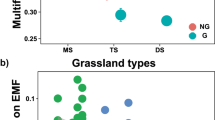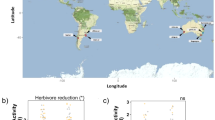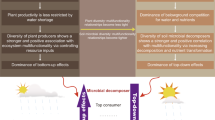Abstract
Perennial plants create productive and biodiverse hotspots, known as fertile islands, beneath their canopies. These hotspots largely determine the structure and functioning of drylands worldwide. Despite their ubiquity, the factors controlling fertile islands under conditions of contrasting grazing by livestock, the most prevalent land use in drylands, remain virtually unknown. Here we evaluated the relative importance of grazing pressure and herbivore type, climate and plant functional traits on 24 soil physical and chemical attributes that represent proxies of key ecosystem services related to decomposition, soil fertility, and soil and water conservation. To do this, we conducted a standardized global survey of 288 plots at 88 sites in 25 countries worldwide. We show that aridity and plant traits are the major factors associated with the magnitude of plant effects on fertile islands in grazed drylands worldwide. Grazing pressure had little influence on the capacity of plants to support fertile islands. Taller and wider shrubs and grasses supported stronger island effects. Stable and functional soils tended to be linked to species-rich sites with taller plants. Together, our findings dispel the notion that grazing pressure or herbivore type are linked to the formation or intensification of fertile islands in drylands. Rather, our study suggests that changes in aridity, and processes that alter island identity and therefore plant traits, will have marked effects on how perennial plants support and maintain the functioning of drylands in a more arid and grazed world.
This is a preview of subscription content, access via your institution
Access options
Access Nature and 54 other Nature Portfolio journals
Get Nature+, our best-value online-access subscription
$29.99 / 30 days
cancel any time
Subscribe to this journal
Receive 12 digital issues and online access to articles
$119.00 per year
only $9.92 per issue
Buy this article
- Purchase on Springer Link
- Instant access to full article PDF
Prices may be subject to local taxes which are calculated during checkout




Similar content being viewed by others
Data availability
The data used for this study are available via Figshare67 at https://doi.org/10.6084/m9.figshare.25283074.v1. The other databases used in this study are: Global Aridity Index and Potential Evapotranspiration Climate Database v2 aridity database (https://cgiarcsi.community/2019/01/24/global-aridity-index-and-potential-evapotranspiration-climate-database-v2/), WorldClim version 2.0 (http://www.worldclim.org/), Woody Plants Database (http://woodyplants.cals.cornell.edu), TRY Database (https://www.try-db.org/TryWeb/Home.php), PLANTS Database (https://plants.usda.gov/) and BROT Database (https://www.uv.es/jgpausas/brot.htm). Source data are provided with this paper.
References
Thiery, J. M., d’Herbes, J. M. & Valentin, C. A model simulating the genesis of banded vegetation patterns in Niger. J. Ecol. 459, 497–507 (1995).
Aguiar, M. R. & Sala, O. E. Patch structure, dynamics and implications for the functioning of arid ecosystems. Trends Ecol. Evol. 14, 273–277 (1999).
Tongway, D. J. & Ludwig, J. A. Small-scale resource heterogeneity in semi-arid landscapes. Pac. Conserv. Biol. 1, 201 (1994).
Ochoa‐Hueso, R. et al. Soil fungal abundance and plant functional traits drive fertile island formation in global drylands. J. Ecol. 106, 242–253 (2018).
Alary, V., Lasseur, J., Frija, A. & Gautier, D. Assessing the sustainability of livestock socio-ecosystems in the drylands through a set of indicators. Agric. Syst. 198, 103389 (2022).
Eldridge, D. J., Delgado‐Baquerizo, M., Travers, S. K., Val, J. & Oliver, I. Do grazing intensity and herbivore type affect soil health? Insights from a semi‐arid productivity gradient. J. Appl. Ecol. 54, 976–985 (2017).
Middleton, N. Rangeland management and climate hazards in drylands: dust storms, desertification and the overgrazing debate. Nat. Hazards 92, 57–70 (2018).
Ding, J. & Eldridge, D. J. The fertile island effect varies with aridity and plant patch type across an extensive continental gradient. Plant Soil 459, 1–11 (2020).
Cai, Y. et al. The fertile island effect collapses under extreme overgrazing: evidence from a shrub-encroached grassland. Plant Soil 448, 201–212 (2020).
Pei, S., Fu, H., Wan, C., Chen, Y. & Sosebee, R. E. Observations on changes in soil properties in grazed and nongrazed areas of Alxa Desert Steppe, Inner Mongolia. Arid Land Res. Manag. 20, 161–175 (2006).
Allington, G. R. & Valone, T. Islands of fertility: a byproduct of grazing? Ecosystems 17, 127–141 (2014).
Maestre, F. T. et al. Grazing and ecosystem service delivery in global drylands. Science 378, 915–920 (2022).
Schade, J. D. & Hobbie, S. E. Spatial and temporal variation in islands of fertility in the Sonoran Desert. Biogeochemistry 73, 541–553 (2005).
Ridolfi, L., Laio, F. & D’Odorico, P. Fertility island formation and evolution in dryland ecosystems. Ecol. Soc. 13, 5 (2008).
Maestre, F. T. et al. Structure and functioning of dryland ecosystems in a changing world. Ann. Rev. Ecol. Evol. Syst. 47, 215–237 (2016).
Charley, J. L. & West, N. E. Plant-induced soil chemical patterns in some shrub-dominated semi-desert ecosystems of Utah. J. Ecol. 63, 945–963 (1975).
DeLuca, T. H. & Zackrisson, O. Enhanced soil fertility under Juniperus communis in arctic ecosystems. Plant Soil 294, 147–155 (2007).
Whitford, W. G., Anderson, J. & Rice, P. M. Stemflow contribution to the ‘fertile island’ effect in creosotebush, Larrea tridentata. J. Arid Environ. 35, 451–457 (1997).
Dunkerley, D. Systematic variation of soil infiltration rates within and between the components of the vegetation mosaic in an Australian desert landscape. Hydrol. Process. 16, 119–131 (2002).
Ward, D. et al. Large shrubs increase soil nutrients in a semi-arid savanna. Geoderma 310, 153–162 (2018).
Hollister, G. B. et al. Shifts in microbial community structure along an ecological gradient of hypersaline soils and sediments. ISME J. 4, 829–838 (2010).
Van Der Heijden, M. G., Bardgett, R. D. & Van Straalen, N. V. The unseen majority: soil microbes as drivers of plant diversity and productivity in terrestrial ecosystems. Ecol. Lett. 11, 296–310 (2008).
Berg, G. Plant–microbe interactions promoting plant growth and health: perspectives for controlled use of microorganisms in agriculture. Appl. Microbiol. Biotech. 84, 11–18 (2009).
Dohn, J. et al. Tree effects on grass growth in savannas: competition, facilitation and the stress‐gradient hypothesis. J. Ecol. 101, 202–209 (2013).
Lai, L. & Kumar, S. A global meta-analysis of livestock grazing impacts on soil properties. PLoS ONE 15, e0236638 (2020).
Schlesinger, W. H. et al. Biological feedbacks in global desertification. Science 247, 1043–1048 (1990).
Reynolds, J. F., Virginia, R. A., Kemp, P. R., De Soyza, A. G. & Tremmel, D. C. Impact of drought on desert shrubs: effects of seasonality and degree of resource island development. Ecol. Monogr. 69, 69–106 (1999).
Funk, J. L. et al. Revisiting the Holy Grail: using plant functional traits to understand ecological processes. Biol. Rev. 92, 1156–1173 (2017).
Grace, J. B. Structural Equation Modeling and Natural Systems (Cambridge Univ. Press, 2006).
Chen, S., Cao, R., Yoshitake, S. & Ohtsuka, T. Stemflow hydrology and DOM flux in relation to tree size and rainfall event characteristics. Agric. For. Meteorol. 279, 107753 (2019).
Fischer, M. et al. Plant species richness and functional traits affect community stability after a flood event. Phil. Trans. R. Soc. B 371, 20150276 (2016).
Verheyen, K. et al. Can complementarity in water use help to explain diversity–productivity relationships in experimental grassland plots? Oecologia 156, 351–361 (2008).
Hook, P. B., Burke, I. C. & Lauenroth, W. K. Heterogeneity of soil and plant N and C associated with individual plants and openings in North American shortgrass steppe. Plant Soil 138, 247–256 (1991).
Ludwig, J. A., Wilcox, B. P., Breshears, D. D., Tongway, D. J. & Imeson, A. C. Vegetation patches and runoff—erosion as interacting ecohydrological processes in semiarid landscapes. Ecology 86, 288–297 (2005).
Eldridge, D. J., Beecham, G. & Grace, J. B. Do shrubs reduce the adverse effects of grazing on soil properties? Ecohydrology 8, 1503–1513 (2015).
Travers, S. K. & Berdugo, M. Grazing and productivity alter individual grass size dynamics in semi-arid woodlands. Ecography 43, 1003–1013 (2020).
Piluzza, G., Sulas, L. & Bullitta, S. Tannins in forage plants and their role in animal husbandry and environmental sustainability: a review. Grass Forage Sci. 69, 32–48 (2014).
De Soyza, A. G., Franco, A. C., Virginia, R. A., Reynolds, J. F. & Whitford, W. G. Effects of plant size on photosynthesis and water relations in the desert shrub Prosopis glandulosa (Fabaceae). Am. J. Bot. 83, 99–105 (1996).
Dean, W. R. G., Milton, S. J. & Jeltsch, F. Large trees, fertile islands, and birds in arid savanna. J. Arid Environ. 41, 61–78 (1999).
Gibb, H. Effects of planting method on the recovery of arboreal ant activity on revegetated farmland. Austral Ecol. 37, 789–799 (2012).
Bolling, J. D. & Walker, L. R. Fertile island development around perennial shrubs across a Mojave Desert chronosequence. West. N. Am. Nat. 62, 88–100 (2002).
Tiedemann, A. R. & Klemmedson, J. O. Long-term effects of mesquite removal on soil characteristics: I: Nutrients and bulk density. Soil Sci. Soc. Am. J. 50, 472–475 (1986).
Belsky, A. J., Mwonga, S. M. & Duxbury, J. M. Effects of widely spaced trees and livestock grazing on understory environments in tropical savannas. Agrofor. Syst. 24, 1–20 (1993).
Maestre, F. T. et al. The BIODESERT survey: assessing the impacts of grazing on the structure and functioning of global drylands. Web Ecol. 22, 75–96 (2022).
Turner, M. D. Long-term effects of daily grazing orbits on nutrient availability in Sahelian West Africa: I: Gradients in the chemical composition of rangeland soils and vegetation. J. Biogeogr. 25, 669–682 (1998).
Rasmussen, H. B., Kahindi, O., Vollrath, F. & Douglas‐Hamilton, I. Estimating elephant densities from wells and droppings in dried out riverbeds. Afr. J. Ecol. 43, 312–319 (2005).
Guerra Alonso, C., Zurita, G. & Bellocq, M. Response of dung beetle taxonomic and functional diversity to livestock grazing in an arid ecosystem. Ecol. Entomol. 46, 582–591 (2020).
Dickinson, C. H., Underhay, V. S. H. & Ross, V. Effect of season, soil fauna and water content on the decomposition of cattle dung pats. New Phytol. 88, 129–141 (1981).
Eldridge, D. J., Poore, A. G. B., Ruiz-Colmenero, M., Letnic, M. & Soliveres, S. Ecosystem structure, function and composition in rangelands are negatively affected by livestock grazing. Ecol. Appl. 36, 1273–1283 (2016).
Travers, S. K., Eldridge, D. J., Koen, T. B., Val, J. & Oliver, I. Livestock and kangaroo grazing have little effect on biomass and fuel hazard in semi-arid woodlands. For. Ecol. Manag. 467, 118165 (2020).
Goutte, C., Toft, P., Rostrup, E., Nielsen, F. A. & Hansen, L. K. On clustering fMRI time series. Neuroimage 9, 298–310 (1999).
Lange, R. T. The piosphere: sheep track and dung patterns. J. Range Manag. 22, 396–400 (1969).
Pringle, H. J. R. & Landsberg, J. Predicting the distribution of livestock grazing pressure in rangelands. Austral Ecol. 29, 31–39 (2004).
Tavşanoğlu, Ç. & Pausas, J. A functional trait database for Mediterranean Basin plants. Sci. Data 5, 180135 (2018).
National Plant Data Team. The PLANTS Database (USDA, 2019).
Kattge, J. et al. TRY—a global database of plant traits. Glob. Change Biol. 17, 2905–2935 (2011).
Kettler, T. A., Doran, J. W. & Gilbert, T. L. Simplified method for soil particle-size determination to accompany soil-quality analyses. Soil Sci. Soc. Am. J. 65, 849–852 (2001).
Armas, C., Ordiales, R. & Pugnaire, F. I. Measuring plant interactions: a new comparative index. Ecology 85, 2682–2686 (2004).
R Core Team. R: a language and environment for statistical computing (R Foundation, 2018).
Fick, S. E. & Hijmans, R. J. WorldClim 2: new 1‐km spatial resolution climate surfaces for global land areas. Int. J. Climatol. 37, 4302–4315 (2017).
Zomer, R. J., Xu, J. & Trabucco, A. Version 3 of the Global Aridity Index and Potential Evapotranspiration Database. Sci. Data 9, 409 (2022).
Zhang, Y.-W., Wang, K.-B., Wang, J., Liu, C. & Shangguan, Z. P. Changes in soil water holding capacity and water availability following vegetation restoration on the Chinese Loess Plateau. Sci. Rep. 11, 9692 (2021).
Carpenter, B. et al. Stan: a probabilistic programming language. J. Stat. Softw. 76, 1–32 (2017).
Goodrich, B., Gabry, J., Ali, I. & Brilleman, S. rstanarm: Bayesian applied regression modeling via Stan. R package version 2.21.1 https://mc-stan.org/rstanarm (R Foundation, 2020).
McElreath, R. Statistical Rethinking 2nd edn (CRC, 2020).
Archer E. rfPermute: estimate permutation P-values for random forest importance metrics. R package version 1. 5. 2 (R Foundation, 2016).
Eldridge, D., Ding, J., Maestre, F. T. BIODESERT Fertile Island. Figshare https://doi.org/10.6084/m9.figshare.25283074.v1 (2024).
Acknowledgements
Funding: This research was supported by the European Research Council (ERC grant 647038 (BIODESERT) awarded to F.T.M.) and Generalitat Valenciana (CIDEGENT/2018/041). D.J.E. was supported by the Hermon Slade Foundation (HSF21040). J. Ding was supported by the National Natural Science Foundation of China Project (41991232) and the Fundamental Research Funds for the Central Universities of China. M.D.-B. acknowledges support from TED2021-130908B-C41/AEI/10.13039/501100011033/Unión Europea Next Generation EU/PRTR and the Spanish Ministry of Science and Innovation for the I + D + i project PID2020-115813RA-I00 funded by MCIN/AEI/10.13039/501100011033. O.S. was supported by US National Science Foundation (Grants DEB 1754106, 20-25166), and Y.L.B.-P. by a Marie Sklodowska-Curie Actions Individual Fellowship (MSCA-1018 IF) within the European Program Horizon 2020 (DRYFUN Project 656035). K.G. and N.B. acknowledge support from the German Federal Ministry of Education and Research (BMBF) SPACES projects OPTIMASS (FKZ: 01LL1302A) and ORYCS (FKZ: FKZ01LL1804A). B.B. was supported by the Taylor Family-Asia Foundation Endowed Chair in Ecology and Conservation Biology, and M. Bowker by funding from the School of Forestry, Northern Arizona University. C.B. acknowledges funding from the National Natural Science Foundation of China (41971131). D.B. acknowledges support from the Hungarian Research, Development and Innovation Office (NKFI KKP 144096), and A. Fajardo support from ANID PIA/BASAL FB 210006 and the Millennium Science Initiative Program NCN2021-050. M.F. and H.E. received funding from Ferdowsi University of Mashhad (grant 39843). A.N. and M.K. acknowledge support from FCT (CEECIND/02453/2018/CP1534/CT0001, SFRH/BD/130274/2017, PTDC/ASP-SIL/7743/2020, UIDB/00329/2020), EEA (10/CALL#5), AdaptForGrazing (PRR-C05-i03-I-000035) and LTsER Montado platform (LTER_EU_PT_001) grants. O.V. acknowledges support from the Hungarian Research, Development and Innovation Office (NKFI KKP 144096). L.W. was supported by the US National Science Foundation (EAR 1554894). Y.Z. and X.Z. were supported by the National Natural Science Foundation of China (U2003214). H.S. is supported by a María Zambrano fellowship funded by the Ministry of Universities and European Union-Next Generation plan. The use of any trade, firm or product names does not imply endorsement by any agency, institution or government. Finally, we thank the many people who assisted with field work and the landowners, corporations and national bodies that allowed us access to their land.
Author information
Authors and Affiliations
Contributions
F.T.M. designed and coordinated the field survey. D.J.E. and J. Ding conceived the study. J. Dorrough undertook the Bayesian analyses, M.M-C. drafted the figures and J. Ding produced the map. Laboratory analyses were performed by V.O., B.G., B.J.M., S.A., A.R., P.D.-M., C.P., N.E., M.C.R., S.C. and M.D.-B. The other authors collected and managed the collection of field data. D.J.E. and J. Ding wrote the draft paper in collaboration with F.T.M. and O.S. and with contributions from all authors.
Corresponding author
Ethics declarations
Competing interests
The authors declare no competing interests.
Peer review
Peer review information
Nature Plants thanks the anonymous reviewers for their contribution to the peer review of this work.
Additional information
Publisher’s note Springer Nature remains neutral with regard to jurisdictional claims in published maps and institutional affiliations.
Supplementary information
Supplementary Information
Supplementary Tables 1–3, Supplementary Figs. 1–8, Supplementary Texts 1–3 and Supplementary References.
Source data
Source Data Fig. 1
Source data for Fig. 1.
Source Data Fig. 2
Source data for Fig. 2.
Source Data Fig. 3
Source data for Fig. 3.
Source Data Fig. 4
Source data for Fig. 4.
Rights and permissions
Springer Nature or its licensor (e.g. a society or other partner) holds exclusive rights to this article under a publishing agreement with the author(s) or other rightsholder(s); author self-archiving of the accepted manuscript version of this article is solely governed by the terms of such publishing agreement and applicable law.
About this article
Cite this article
Eldridge, D.J., Ding, J., Dorrough, J. et al. Hotspots of biogeochemical activity linked to aridity and plant traits across global drylands. Nat. Plants (2024). https://doi.org/10.1038/s41477-024-01670-7
Received:
Accepted:
Published:
DOI: https://doi.org/10.1038/s41477-024-01670-7



